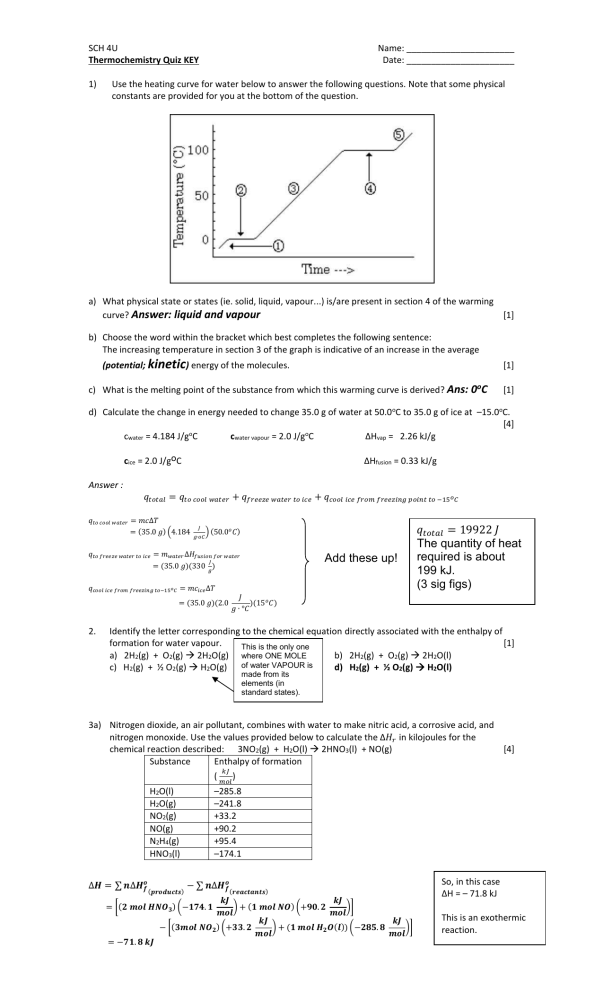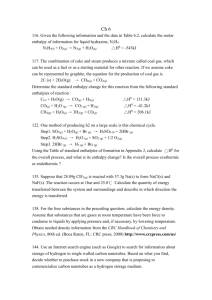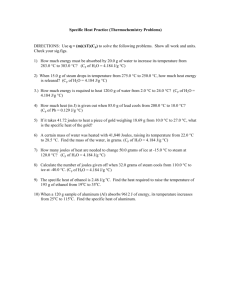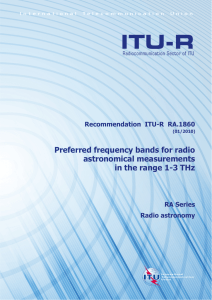kinetic - mquagliaoths
advertisement

SCH 4U Thermochemistry Quiz KEY 1) Name: ______________________ Date: ______________________ Use the heating curve for water below to answer the following questions. Note that some physical constants are provided for you at the bottom of the question. a) What physical state or states (ie. solid, liquid, vapour...) is/are present in section 4 of the warming curve? Answer: liquid and vapour [1] b) Choose the word within the bracket which best completes the following sentence: The increasing temperature in section 3 of the graph is indicative of an increase in the average (potential; kinetic) energy of the molecules. [1] c) What is the melting point of the substance from which this warming curve is derived? Ans: 0oC [1] d) Calculate the change in energy needed to change 35.0 g of water at 50.0 oC to 35.0 g of ice at –15.0oC. [4] cwater = 4.184 J/goC cwater vapour = 2.0 J/goC ΔHvap = 2.26 kJ/g cice = 2.0 J/goC ΔHfusion = 0.33 kJ/g Answer : 𝑞𝑡𝑜𝑡𝑎𝑙 = 𝑞𝑡𝑜 𝑐𝑜𝑜𝑙 𝑤𝑎𝑡𝑒𝑟 + 𝑞𝑓𝑟𝑒𝑒𝑧𝑒 𝑤𝑎𝑡𝑒𝑟 𝑡𝑜 𝑖𝑐𝑒 + 𝑞𝑐𝑜𝑜𝑙 𝑖𝑐𝑒 𝑓𝑟𝑜𝑚 𝑓𝑟𝑒𝑒𝑧𝑖𝑛𝑔 𝑝𝑜𝑖𝑛𝑡 𝑡𝑜 −15𝑜 𝐶 𝑞𝑡𝑜 𝑐𝑜𝑜𝑙 𝑤𝑎𝑡𝑒𝑟 = 𝑚𝑐∆𝑇 = (35.0 𝑔) (4.184 𝐽 𝑔∙𝑜𝐶 ) (50.0𝑜 𝐶) 𝑞𝑡𝑜 𝑓𝑟𝑒𝑒𝑧𝑒 𝑤𝑎𝑡𝑒𝑟 𝑡𝑜 𝑖𝑐𝑒 = 𝑚𝑤𝑎𝑡𝑒𝑟 ∆𝐻𝑓𝑢𝑠𝑖𝑜𝑛 𝑓𝑜𝑟 𝑤𝑎𝑡𝑒𝑟 Add these up! 𝐽 = (35.0 𝑔)(330 ) 𝑔 𝑞𝑐𝑜𝑜𝑙 𝑖𝑐𝑒 𝑓𝑟𝑜𝑚 𝑓𝑟𝑒𝑒𝑧𝑖𝑛𝑔 𝑡𝑜−15𝑜𝐶 = 𝑚𝑐𝑖𝑐𝑒 ∆𝑇 = (35.0 𝑔)(2.0 2. 𝑞𝑡𝑜𝑡𝑎𝑙 = 19922 𝐽 The quantity of heat required is about 199 kJ. (3 sig figs) 𝐽 )(15𝑜 𝐶) 𝑔 ∙ °𝐶 Identify the letter corresponding to the chemical equation directly associated with the enthalpy of formation for water vapour. [1] This is the only one a) 2H2(g) + O2(g) 2H2O(g) where ONE MOLE b) 2H2(g) + O2(g) 2H2O(l) c) H2(g) + ½ O2(g) H2O(g) of water VAPOUR is d) H2(g) + ½ O2(g) H2O(l) made from its elements (in standard states). 3a) Nitrogen dioxide, an air pollutant, combines with water to make nitric acid, a corrosive acid, and nitrogen monoxide. Use the values provided below to calculate the Δ𝐻𝑟 in kilojoules for the chemical reaction described: 3NO2(g) + H2O(l) 2HNO3(l) + NO(g) [4] Substance Enthalpy of formation 𝑘𝐽 ( ) 𝑚𝑜𝑙 H2O(l) H2O(g) NO2(g) NO(g) N2H4(g) HNO3(l) ∆𝑯 = ∑ 𝒏∆𝑯𝒐𝒇 (𝒑𝒓𝒐𝒅𝒖𝒄𝒕𝒔) –285.8 –241.8 +33.2 +90.2 +95.4 –174.1 − ∑ 𝒏∆𝑯𝒐𝒇 (𝒓𝒆𝒂𝒄𝒕𝒂𝒏𝒕𝒔) 𝒌𝑱 𝒌𝑱 ) + (𝟏 𝒎𝒐𝒍 𝑵𝑶) (+𝟗𝟎. 𝟐 )] 𝒎𝒐𝒍 𝒎𝒐𝒍 𝒌𝑱 𝒌𝑱 − [(𝟑𝒎𝒐𝒍 𝑵𝑶𝟐 ) (+𝟑𝟑. 𝟐 ) + (𝟏 𝒎𝒐𝒍 𝑯𝟐 𝑶(𝒍)) (−𝟐𝟖𝟓. 𝟖 )] 𝒎𝒐𝒍 𝒎𝒐𝒍 So, in this case ΔH = – 71.8 kJ = [(𝟐 𝒎𝒐𝒍 𝑯𝑵𝑶𝟑 ) (−𝟏𝟕𝟒. 𝟏 = −𝟕𝟏. 𝟖 𝒌𝑱 This is an exothermic reaction. b) Your result for part a) is calculated based on the chemical equation above which shows that 1 mole of NO(g) is produced in the reaction process. If 250.0 g of NO(g) is involved in the reaction above, 𝑘𝐽 what will the enthalpy change for the reaction be in of NO(g)? [2] 𝑛𝑁𝑂 = 𝑚𝑜𝑙 𝑚 𝑚𝑚 𝑆𝑜, ∆𝐻 𝑤𝑖𝑙𝑙 𝑏𝑒 250 𝑔 = 𝑔 30.0 𝑚𝑜𝑙 −71.8 𝑘𝐽 × 8.33 𝑚𝑜𝑙 𝑜𝑓 𝑁𝑂 𝑚𝑜𝑙 𝑜𝑓 𝑁𝑂 In this case, about 598 kJ of energy will be released; ΔH = – 598 kJ (3 sig figs) ∆𝐻 = −598.094 𝑘𝐽 = 8.33 𝑚𝑜𝑙 4 a) Write a balanced chemical equation for the complete combustion of one mole of ethanol vapour, C2H5OH(g), showing Lewis structures for all reactants and products. All reactants and products need to be shown in the gaseous state. [2] 2 + + 3 b) Use data from the table below to calculate the heat of combustion for ethanol vapour, ΔHc, in kJ/mol of ethanol vapour burned. [4] ΔH= 𝑛∆𝐻°𝑟𝑒𝑞𝑢𝑖𝑟𝑒𝑑 𝑡𝑜 𝑏𝑟𝑒𝑎𝑘 𝑡ℎ𝑒 𝑏𝑜𝑛𝑑𝑠 𝑖𝑛 𝑡ℎ𝑒 𝑟𝑒𝑎𝑐𝑡𝑎𝑛𝑡𝑠 − ∑ 𝑛∆𝐻°𝑟𝑒𝑙𝑒𝑎𝑠𝑒𝑑 𝑏𝑦 𝑏𝑜𝑛𝑑 𝑓𝑜𝑟𝑚𝑎𝑡𝑖𝑜𝑛 𝑖𝑛 𝑡ℎ𝑒 𝑝𝑟𝑜𝑑𝑢𝑐𝑡𝑠 𝑘𝐽 𝑘𝐽 𝑘𝐽 𝑘𝐽 ) + (1 𝑚𝑜𝑙 𝑂𝐻 𝑏𝑜𝑛𝑑) (460 ) + (1 𝑚𝑜𝑙 𝐶 − 𝑂 𝑏𝑜𝑛𝑑) (351 ) + (1 𝑚𝑜𝑙 𝑂 = 𝑂 𝑏𝑜𝑛𝑑)(499 )] 𝑚𝑜𝑙 𝑚𝑜𝑙 𝑚𝑜𝑙 𝑚𝑜𝑙 𝑘𝐽 𝑘𝐽 − [(4 𝑚𝑜𝑙 𝐶 = 𝑂 𝑏𝑜𝑛𝑑𝑠) (799 ) + (6 𝑚𝑜𝑙 𝑂𝐻 𝑏𝑜𝑛𝑑𝑠) (460 )] 𝑚𝑜𝑙 𝑚𝑜𝑙 = [(5 𝑚𝑜𝑙 𝐶𝐻 𝑏𝑜𝑛𝑑𝑠) (414 = −2576 𝑘𝐽 So, ΔHc = – 2576 𝑘𝐽 (3 sig figs) and because for the equation is balanced for one mole of ethanol we can say that ΔHc = – 2576 𝑚𝑜𝑙 𝑘𝐽 𝑚𝑜𝑙 . c) Write a balanced thermochemical equation for the complete combustion of ethanol vapour including the physical state of all reactants and products. [2] C2H5OH(g) + O2(g) 2 CO2(g) + 3 H2O(g) + 2576 Or C2H5OH(g) + O2(g) 2 CO2(g) + 3 H2O(g) 𝑘𝐽 𝑚𝑜𝑙 𝑜𝑓 𝑒𝑡ℎ𝑎𝑛𝑜𝑙 (In an exothermic reaction, heat is a product.) ΔHc = – 2576 𝑘𝐽 𝑚𝑜𝑙 for ethanol (ΔH is negative for an exothermic reaction.) 5. Bond Type Average bond enthalpy in kJ/mol C-H +414 C-C +347 O=O +499 C=O +745 (in CO2 = +799) H-O +460 H-H +436 C=C +620 N-H +393 C-O +351 O-O +142 Calculate ΔH for the reaction 4 NH3 (g) + 5 O2 (g) 4 NO (g) + 6 H2O (g), from the following data. N2 (g) + O2 (g) 2 NO (g) ΔH = -180.5 kJ N2 (g) + 3 H2 (g) 2 NH3 (g) ΔH = -91.8 kJ 2 H2 (g) + O2 (g) 2 H2O (g) ΔH = -483.6 kJ Answer using Hess’s Law and manipulations of the balanced eqautions and their associated changes in enthalpy: rev and x2 4 NH3(g) 2 N2(g) + 6 H2(g) ΔH = (2)(+91.8 kJ) x2 2 N2 (g) + 2 O2 (g) 4 NO (g) ΔH = (2) (-180.5 kJ) x3 6 H2 (g) + 3 O2 (g) 6 H2O (g) ΔH = (3) (-483.6 kJ) 4 NH3 (g) + 5 O2 (g) 4 NO (g) + 6 H2O (g) ΔH= – 1995.4 kJ [4]








